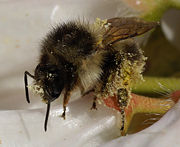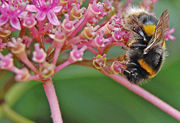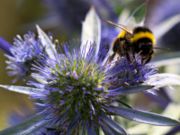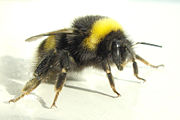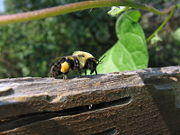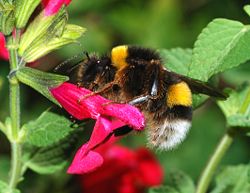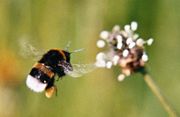Bumblebee
2008/9 Schools Wikipedia Selection. Related subjects: Insects, Reptiles and Fish
| Bombus | ||||||||||||||||
|---|---|---|---|---|---|---|---|---|---|---|---|---|---|---|---|---|
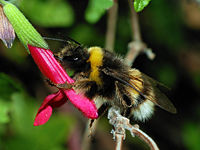 male Bombus terrestris robbing nectar
|
||||||||||||||||
| Scientific classification | ||||||||||||||||
|
||||||||||||||||
| Species | ||||||||||||||||
|
more than 250 species and subspecies in 38 subgenera |
Bumblebees (also spelled bumble bee, also known as humblebee) are flying insects of the genus Bombus in the family Apidae.
Bumblebees are social insects that are characterized by black and yellow body hairs, often in bands. However, some species have orange or red on their bodies, or may be entirely black. Another obvious (but not unique) characteristic is the soft nature of that hair (long, branched setae), called pile, that covers their entire body, making them appear and feel fuzzy. They are best distinguished from similarly large, fuzzy bees by the form of the female hind leg, which is modified to form a corbicula; a shiny concave surface that is bare, but surrounded by a fringe of hairs used to transport pollen (in similar bees, the hind leg is completely hairy, and pollen grains are wedged into the hairs for transport).
Like their relatives the honey bees, bumblebees feed on nectar and gather pollen to feed their young.
Biology
Anatomy
The blood or hemolymph, as in other arthropods, is carried in an open circulatory system. The body organs, heart, muscles, etc. are surrounded in a reservoir of blood. The heart does pulse blood through its long tube, though, so there is a circulation of sorts.
In fertilised queens the ovaries are activated and when the queen lays her egg it passes along the oviduct to the vagina. In the vagina there is a container called the spermatheca. This is where the queen stored sperm from her mating. Before she lays the egg she will decide whether to use sperm from the spermatheca to fertilise it or not. Non-fertilised eggs grow into male bumblebees, and only fertilised eggs grow into females and queens.
As in all animals hormones play a big role in the growth and development of the bumblebee. The hormones that stimulate the development of the ovaries are suppressed in the other female worker bees while the queen remains dominant. Salivary glands in the head secrete saliva which is mixed with the nectar and pollen. Saliva is also mixed into the nest materials to soften them.
The bumblebee tongue is specialised to suck up nectar via capillary action. At rest or when flying the tongue is kept inside a sheath and folded under the head and thorax. The abdomen is covered with dorsal tergites and ventral sternites. Wax is secreted between these plates.
The brightly-coloured pile of the bumble bee is a form of aposematic signal. Depending on the species and morph, these colours can range from entirely black, to bright yellow, red, orange, white, and pink. Thick pile can also act as insulation to keep the bee warm in cold weather. Further, when flying a bee builds up an electrostatic charge, and as flowers are usually well grounded, pollen is attracted to the bee's pile when it lands. When a pollen covered bee enters a flower, the charged pollen is preferentially attracted to the stigma because it is better grounded than the other parts of the flower.
A bumblebee does not have ears, and it is not known whether or how a bumblebee can hear sound waves passing through the air, however they can feel the vibrations of sounds through wood and other materials. The heart, like that in most other insects, runs down the entire length of the body. The fat body is a nutritional store. Before hibernation queens eat as much as they can to enlarge their fat body. The fat in the cells is used up during hibernation.
Habitat
Bumblebees are typically found in higher latitudes and/or high altitudes, though exceptions exist (there are a few lowland tropical species). A few species ( Bombus polaris and B. alpinus) range into very cold climates where other bees might not be found; B. polaris can be found in northern Ellesmere Island - the northernmost occurrence of any eusocial insect - along with its parasite, B. hyperboreus. One reason for this is that bumblebees can regulate their body temperature, via solar radiation, internal mechanisms of "shivering" and radiative cooling from the abdomen (called heterothermy). Other bees have similar physiology, but it has been best studied in bumblebees.
Nests
Bumblebees form colonies. However, their colonies are usually much less extensive than those of honey bees. This is due to a number of factors including: the small physical size of the nest cavity, the fact that a single female is responsible for the initial construction and reproduction that happens within the nest, and the restriction of the colony to a single season (in most species). Often, mature bumblebee nests will hold fewer than 50 individuals, and may be within tunnels in the ground made by other animals, or in tussock grass. Bumblebees sometimes construct a wax canopy ("involucrum") over top of their nest for protection and insulation. Bumblebees mostly do not preserve their nests through the winter, though some tropical species live in their nests for several years (and their colonies can grow quite large, depending on the size of the nest cavity). The last generation of summer includes a number of queens who overwinter separately in protected spots. The queens can live up to one year, possibly longer in tropical species.
Colony cycle
Bumblebee nests are first constructed by over-wintered queens in the spring (in temperate areas). Upon emerging from hibernation, the queen collects pollen and nectar from flowers and searches for a suitable nest site. The characteristics of the nest site vary among bumble bee species, with some species preferring to nest in underground holes and others in tussock grass or directly on the ground. Once the queen has found a site, she prepares wax pots to store food and wax cells into which eggs are laid. These eggs then hatch into larvae, which cause the wax cells to expand isometrically into a clump of brood cells.
These larvae need to be fed both nectar for carbohydrates and pollen for protein in order to develop. Bumblebees feed larvae nectar by chewing a small hole in the brood cell into which nectar is regurgitated. Larvae are fed pollen in two ways, depending on the bumblebee species. So called "pocket-maker" bumblebees create pockets of pollen at the base of the brood cell clump from which the larvae can feed themselves. Conversely, "pollen-storer" store pollen in separate wax pots and feed it to the larva in the same fashion as nectar. Bumble bees are incapable of trophallaxis.
With proper care, the larvae progress through four instars, becoming successively larger with each molt. At the end of the fourth instar the larvae spin a silk cocoon under the wax covering the brood cell, changing it into a pupal cell. The larvae then undergo an intense period of cellular growth and differentiation and become pupae. These pupae then develop into adult bees, who chew their way out of the silk cocoon. When adult bumble bees first emerge from their cocoons, the hairs on their body are not yet fully pigmented and are a greyish-white colour. The bees are referred to as "callow" during this time, and they will not leave the colony for at least 24 hours. The entire process from egg to adult bee can take as long as five weeks, depending on the species and the environmental conditions.
After the emergence of the first or second group of workers, workers take over the task of foraging and the queen spends most of her time laying eggs and caring for larvae. The colony grows progressively larger and at some point will begin to produce males and new queens. The point at which this occurs varies among species and is heavily dependant on resource availability and environmental factors. Unlike the workers of more advanced social insects, bumble bee workers are not physically reproductively sterile and are able to lay haploid eggs that develop into viable male bumble bees. Only fertilized queens can lay diploid eggs that mature into workers and new queens.
Early in the colony cycle, the queen bumble bee compensates for potential reproductive competition from workers by suppressing their egg-laying by way of physical aggression and pheromonal signals. Thus, the queen will usually be the mother of all of the first males laid. Workers eventually begin to lay males later in the season when the queen's ability to suppress their reproduction diminishes. The reproductive competition between workers and the queen is one reason that bumble bees are considered "primitively eusocial".
New queens and males leave the colony after maturation. Males in particular are forcibly driven out by the workers. Away from the colony, the new queens and males live off nectar and pollen and spend the night on flowers or in holes. The queens are eventually mated (often more than once) and search a for suitable location for diapause.
Foraging behaviour
Bumblebees generally visit flowers exhibiting the bee pollination syndrome. They can visit patches of flowers up to 1-2 kilometres from their colony. Bumblebees will also tend to visit the same patches of flowers every day, as long as nectar and pollen continue to be available. While foraging, bumblebees can reach ground speeds of up to 15 m/s (54 km/h).
When bumblebees arrive at a flower, they extract nectar using their long tongue (" glossa") and store it in their crop. Many species of bumblebee also exhibit what is known as "nectar robbing": instead of inserting the mouthparts into the flower normally, these bees bite directly through the base of the corolla to extract nectar, avoiding pollen transfer. These bees obtain pollen from other species of flowers that they "legitimately" visit.
Pollen is removed from flowers deliberately or incidentally by bumblebees. Incidental removal occurs when bumblebees come in contact with the anthers of a flower while collecting nectar. The bumblebee's body hairs receive a dusting of pollen from the anthers which is then groomed into the corbiculae ("pollen baskets"). Bumblebees are also capable of buzz pollination.
In at least a few species, once a bumblebee has visited a flower, it leaves a scent mark on the flower. This scent mark deters visitation of the flower by other bumblebees until the scent degrades.. It has been shown that this scent mark is a general chemical bouquet that bumblebees leave behind in different locations (e.g. nest, neutral and food sites), and they learn to use this bouquet to identify both rewarding and unrewarding flowers. In addition, bumblebees rely on this chemical bouquet more when the flower has a high handling time (i.e. it takes a longer time for the bee to find the nectar).
Once they have collected nectar and pollen, bumblebees return to the nest and deposit the harvested nectar and pollen into brood cells, or into wax cells for storage. Unlike honey bees, bumblebees only store a few days' worth of food and so are much more vulnerable to food shortages. However, because bumblebees are much more opportunistic feeders than honey bees, these shortages may have less profound effects. Nectar is stored essentially in the form it was collected, rather than being processed into honey as is done in honey bees; it is therefore very dilute and watery, and is rarely consumed by humans.
"Cuckoo" bumblebees
Bumblebees of the subgenus Psithyrus (known as cuckoo bumblebees, and formerly considered a separate genus) are a lineage which has lost the ability to collect pollen, and live parasitically in the colonies of other bumblebees. Before finding and invading a host colony, a Psithyrus female (there is no caste system in these species) will feed directly from flowers. Once she has infiltrated a host colony, the Psithyrus female will kill or subdue the queen of that colony and forcibly (using pheromones and/or physical attacks) "enslave" the workers of that colony to feed her and her young. The female Psithyrus also has a number of morphological adaptations, such as larger mandibles and a larger venom sac that increase her chances of taking over a nest. Upon hatching, the male and female Psithyrus disperse and mate. Like non-parasitic bumblebee queens, female Psithyrus find suitable locations to spend the winter and enter diapause upon being mated.
Reproduction
In temperate zone species, in the autumn, young queens (" gynes") mate with males ( drones) and diapause during the winter in a sheltered area, whether in the ground or in a man-made structure. In the early spring, the queen comes out of diapause and finds a suitable place to create her colony, and then builds wax cells in which to lay her fertilized eggs from the previous winter. The eggs that hatch develop into female workers, and in time the queen populates the colony, with workers feeding the young and performing other duties similar to honey bee workers. New reproductives are produced in autumn, and the queen and workers die, as do the males.
Sting
Queen and worker bumblebees can sting, but, like virtually all bees, the sting is not barbed (only honey bees have a barbed sting), so they can sting more than once. Bumblebee species are non-aggressive, but will sting in defense of their nest, or if harmed. Female cuckoo bumblebees will aggressively attack host colony members, and sting the host queen, but will ignore other animals (including humans) unless disturbed. See Schmidt Sting Pain Index.
Bumblebees and people
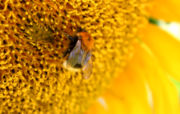
Bumblebees are important pollinators of both crops and wildflowers.
Agricultural use
Bumblebees are increasingly cultured for agricultural use as pollinators because they can pollinate plant species that other pollinators cannot by using a technique known as buzz pollination. For example, bumblebee colonies are often emplaced in greenhouse tomato production, because the frequency of buzzing that a bumblebee exhibits effectively releases tomato pollen.
The agricultural use of bumblebees is limited to pollination. Because bumblebees do not overwinter the entire colony, they are not obliged to stockpile honey, and are therefore not useful as honey producers.
Endangered status
Bumblebees are in danger in many developed countries due to habitat destruction and collateral pesticide damage. In Britain, until relatively recently, 19 species of native true bumblebee were recognised along with six species of cuckoo bumblebees. Of these, three have already become extinct, eight are in serious decline and only six remain widespread. A decline in bumblebee numbers could cause large-scale sweeping changes to the countryside, leading to inadequate pollination of certain plants.
In response to this, a new organisation has recently been set up - The Bumblebee Conservation Trust aims to halt these declines through conservation and education (see links).
Bumblebee myths
Flight
According to 20th century folklore, the laws of aerodynamics prove that the bumblebee should be incapable of flight, as it does not have the capacity (in terms of wing size or beat per second) to achieve flight with the degree of wing loading necessary. Not being aware of scientists 'proving' it cannot fly, the bumblebee succeeds under "the power of its own arrogance". The origin of this myth has been difficult to pin down with any certainty. John McMasters recounted an anecdote about an unnamed Swiss aerodynamicist at a dinner party who performed some rough calculations and concluded, presumably in jest, that according to the equations, bumblebees cannot fly. In later years McMasters has backed away from this origin, suggesting that there could be multiple sources, and that the earliest he has found was a reference in the 1934 French book Le vol des insectes by M. Magnan. Magnan is reported to have written that he and a Mr. Saint-Lague had applied the equations of air resistance to insects and found that their flight was impossible, but that "One shouldn't be surprised that the results of the calculations don't square with reality".
It is believed that the calculations which purported to show that bumblebees cannot fly are based upon a simplified linear treatment of oscillating aerofoils. The method assumes small amplitude oscillations without flow separation. This ignores the effect of dynamic stall, an airflow separation inducing a large vortex above the wing, which briefly produces several times the lift of the aerofoil in regular flight. More sophisticated aerodynamic analysis shows that the bumblebee can fly because its wings encounter dynamic stall in every oscillation cycle.
Buzz
One common, yet incorrect, assumption is that the buzzing sound of bees is caused by the beating of their wings. The sound is the result of the bee vibrating its flight muscles, and this can be done while the muscles are decoupled from the wings, a feature known in bees but not possessed by other insects. This is especially pronounced in bumblebees, as they must warm up their bodies considerably to get airborne at low ambient temperatures. This is how bumblebees can sometimes reach an internal thoracic temperature of 30 degrees Celsius (86 degrees Fahrenheit).
Selected species
For a complete list, see List of world bumblebee species.
- Bombus fraternus
- Early Bumblebee, Bombus pratorum
- Orange-belted bumblebee Bombus ternarius
- Buff-Tailed bumblebee, or Large Earth Bumblebee, Bombus terrestris
Associated parasites
- Tracheal mites - Locustacarus buchneri
- Protozoans- Crithidia bombi
- Microsporidia- Nosema bombi
In popular culture
- "Dumbledor" (or "dumbledore") is an old Devon name for the bumblebee. The bumblebee's buzzing sound is the quality for which they (as well as the cockchafer or scarab beetle) are given this name. Dor is applied in names like dorbeetle, dorbug, and dorfly, to refer to a humming or drone noise produced by the particular insect. This name was picked by J.K. Rowling for her character Albus Dumbledore because she imagines him wandering around the castle humming to himself.
- In the north-east of Scotland bumblebees are known as 'foggy bummers'.
- The Flight of the Bumblebee is a famous orchestral interlude written by Nikolai Rimsky-Korsakov for his opera The Tale of Tsar Saltan, composed in 1899-1900.
- The young Autobot Bumblebee is one of the characters of the Transformers series.
- The character Bumblebee Man from The Simpsons is a Mexican slapstick comedian who dresses in a bumblebee costume. He is based on El Chapulín Colorado, a famous Mexican comedy character who dresses in a red grasshopper costume.
- Buck Bumble was a Nintendo 64 game starring the titular Bee in battle against villainous bugs.
